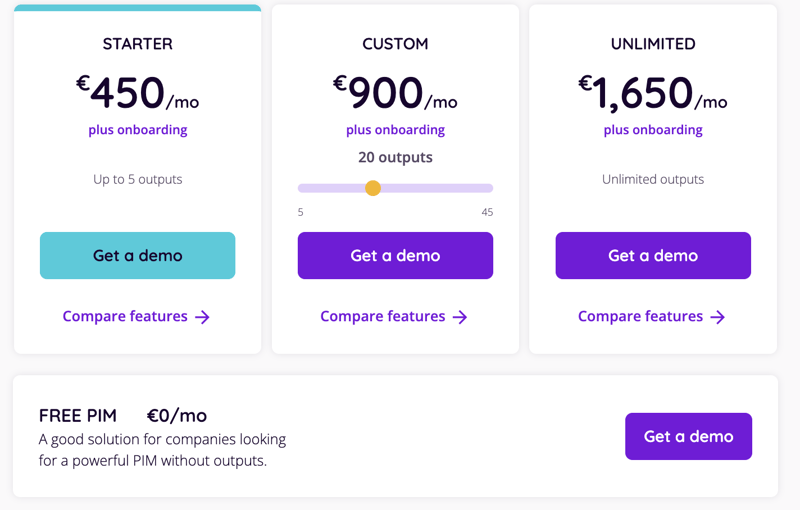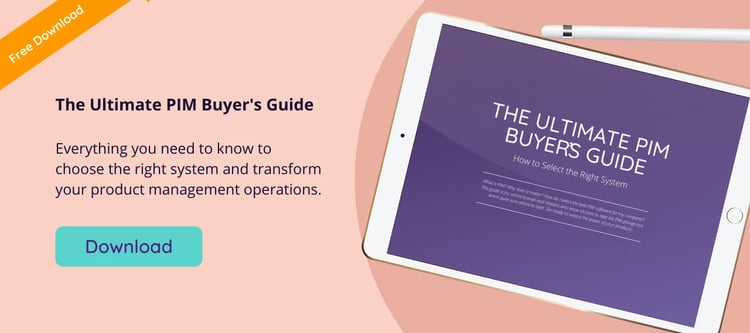You may have come across Plytix when searching for a product database tool that can help you store and manage product information from a single source of truth. Or on YouTube, or perhaps you’ve read a G2 review on how we’re one of the best commerce software for SMBs.
However you got here, we’re happy you found us.
The term product information management can mean a number of things for different people. Which is why you may have lingering questions about “what is Plytix?” and “what is product information management?” Continue reading to find out everything you need to know.
Who is Plytix for?
There are many PIM tools on the market, and they all cater to different needs.
However, there is nothing quite like us. Plytix is specifically designed for small to medium-sized companies that are selling on multiple channels and looking to get their products out there. We know how expensive PIM software can be and how hard it is for smaller companies to get real estate online compared to ecommerce giants. This is why we are focused on creating the best solution for SMBs to ensure that brand diversity is achievable in ecommerce.
How do I get started?
Getting started with Plytix is simple. Just request a demo and fill out the form with your company contact details. Then, choose a time for a quick 15-minute call with our team. During the call, we’ll discuss your needs to make sure Plytix is the right PIM for you.
Once you’re confident that it is, we’ll schedule a full demo. Don’t worry; we won’t take up more of your time than necessary. We’ll customize the demo to show you how Plytix can help you achieve your goals with real-life examples. If all goes well—and we’re confident it will—the next step will be to set you up with your own Customer Success Manager.
Your Customer Success Manager will coach you through your account kickoff, import your product data for you, and get your account set up to meet your needs. They’ll also create a personalized roadmap to ensure you reach your goals. The best part? Their support doesn’t stop. There’s no finish line where we consider your account “done”—we’ll be with you every step of the way.
Are there any other fees involved?
Besides the ones on our pricing page? No! When we say that we're “built and priced for small teams with big ambitions,” we mean it. We aren’t in the business of giving customers a nasty surprise with hidden fees that end up costing an arm and a leg. What you see is what you get.
Do you offer dedicated customer support?
We do! Plytix is built for content people, so no technical skills are needed to use it. But to make sure you get the most out of your account, you’ll have a dedicated Customer Success Manager from day one. They’ll import your data and set up your account for you, so you can jump right in and start reaching your goals—whether that’s getting your products to market faster or making sure each one has the right marketing content.
And since your goals go beyond just the first few months, so does our support. There’s no “you’re on your own” moment here. We believe in continuous coaching, so we’re with you every step of the way.
Want even more tips? Check out our blogs, YouTube videos, and Help Center for everything PIM-related.
How long is implementation?
At Plytix, there’s no drawn-out onboarding. We know you’re short on time, and waiting months to see results just isn’t an option. Our aim is for your Plytix account to bring you value from the moment you launch it.
That’s why we set up your account for you. We’ll get to know your product data and workflows, import your product lists, and structure everything so it’s organized from day one. But it isn’t a one-size-fits-all process. Your needs will evolve, and we’ll be there to fine-tune your setup as you grow—helping you adapt, optimize, and reach new goals. In that sense, implementation never really ends.
Do I need to hire IT or add more people to my team?
No, you don’t need a big or technical team when using PIM. But, if you need to connect the system using an API, you’ll need a developer as it becomes complex for non-tech savvy users.
What if I don’t need all the features?
With Plytix, you don’t have to be tied down to features you don’t need.
As we mentioned before, we have a white-glove approach, so we focus on your needs and take it from there. It’s all up to you, your budget, and how you wish to scale your business. You can mix and match and build your ideal plan with our add-ons. For example, you can start with the Basic plan with three outputs, and then add on additional channels as and when you need them for a flat rate per output.
How will Channels help me sell products on different marketplaces?
Selling on different marketplaces means having a variety of product information, titles, descriptions, and media in different styles and formats to suit the channel you're selling on.
With the Channels feature, you’re able to view all your product information in one central dashboard. This is a location where you can pull tailored product content that meets channel-specific needs in its correct sizing and naming conventions and distribute it to any social media, marketplace or comparison search engine (CSE) channel. This also enables you to easily tweak, improve and optimize content to ensure it ranks well on different sales channels.
Because our PIM comes equipped with digital asset management (DAM) capabilities, you won’t have to work on various software. To distribute to various platforms, all you need to do is;
- Upload a CSV template from any of your sales channels or create your own in PIM by choosing the product attributes you need for a specific channel
- Use our open API to create a custom integration to your specific sales channel
Does this mean Plytix is a feed management system?
No, we aren’t a data feed management system (FMS), but we sit on top of your existing one.
You can integrate Plytix with feed systems to cover the gaps or limitations you might have with a standard system. Joining a PIM system with a feed management tool means you’ll have a highly optimized feed with rich, accurate product information. Together, these tools can help ensure that your product information is optimized for each channel and error-free.
That way, when you add content to your feed management system, you can rest assured knowing that you’re importing quality product information. If you don’t have a data feed management system, that’s okay because our Channels module can act as a substitute.
What sales channels can I send content to using Plytix?
Plytix is platform-agnostic, meaning we can help you get your products wherever they need to go. Whether you’re sending to Google Shopping, Amazon, ecommerce platforms, eBay, Etsy, or anywhere else, we’ve got you. Complete this Channels integration form to find out more.
Why would I need Brand Portals when I have a website?
Brand Portals isn’t trying to replace your website. This module helps you create sales enablement materials such as digital catalogs that can help you showcase your products.
Let’s say you need to send an online catalog to a distributor, reseller, or need to share product information with someone in-house instead of scrambling to figure out how to use InDesign.
You can simply create a Brand Portal.
Since your product information is already in PIM, you can create a catalog in a matter of minutes. And because it’s live, you can update catalogs and have it reflect immediately.
How can I share product information with my clients?
Our Channels and Brand Portals can help you with this.
With the Brand Portal, you can share it as a PDF, CSV, or XLSX with media assets in a zip file.
Where is Plytix's customer support based?
Our main customer support is based in our production house in Málaga, Spain, but we also have customer support agents in the United States. The reason for this is that we wanted to be able to offer our customers support wherever our customers need it. This is why our quality of support rating on G2 is 9.8, as we always try to ensure that we respond in a timely manner.
What out-of-the-box integrations do we have?
We have a Shopify connector to help users seamlessly connect PIM to their ecommerce store. We also have product content syndication abilities for Google Shopping, Instagram, Facebook catalogs, and any other system where we can fetch a URL feed using the Channels module.
How do you pronounce Plytix?
Our name is derived from two separate departments and joined together as one: Product and Analytics. It’s pronounced Plee-Ticks. Read more about our story and how we started here.
What are the API limitations?
Our API allows customers to integrate the PIM solution with third-party tools.
The major limitation of the Plytix Rest API is the number of requests that can be made for a client within a certain time frame. If you have a Free Plan, you’re allowed 20 requests every 10 seconds, and they’re capped at 2000 requests per hour. However, on a PRO Plan, each API key is allowed 50 requests every 10 seconds, and they’re capped at 5000 requests per hour.
Are there other limitations? Is data storage really unlimited?
If you’re on the Free Plan, there are a couple of limitations you’ll experience. For example, you won’t have unlimited space as you’re capped at 5 GB file space and an API limitation, but with the Standard and PRO versions, you have unlimited data storage and so much more.
These features make multichannel ecommerce easier.
What kind of contract plans are there?
Because we know that each customer is different, we have created three core plans for customers to choose from. We have a free plan that’s great for companies that are tired of using a number of spreadsheets and Dropbox folders. With the Free Plan, users get access to unlimited users, 5000 SKUs, 5GB file storage, Limited API, Digital asset management (not to be confused with a digital brand asset management tool), and a Google Analytics integration.
Then, we have the Standard Plan, which costs €300 per month (excluding the setup fee). This is ideal for SMBs that want to take their product management to the next level with 100 000 SKUs, unlimited file storage and API, scheduled imports, custom user roles, dedicated customer support, and one Channel and Brand Portal.
The PRO plan costs €1100 per month (excluding the setup fee) and includes the existing features from the Standard Plan with unlimited Channels, unlimited Brand Portals, and unlimited Product Sheets. Customers can mix and match what they need, and our plans are paid monthly. You'll get a €200 discount if you go straight to PRO versus the mix and match.
Is the free plan temporary?
No, you can use the free plan for however long you want at absolutely no charge. But, if you plan on scaling up your ecommerce store or want to invest in a multichannel strategy, it is advised that you get the Standard Plan or the mix and match option to see better results.
Where do we host everything? On what servers?
Plytix stores all its data in Amazon’s Simple Cloud Storage Service (S3). This is one of the cloud services with the tightest security available. We use this service to ensure that our customers' product data is secure and runs fast in all parts of the world. We’re built with MongoDB, a document-oriented database that’s used to store all product information and account data.
How safe is my data with Plytix?
Well, we use the safest servers, and all passwords are encrypted with SHA-256 and salted with randomized values to ensure it’s safe from anyone, including the Plytix staff. Our agents also are authenticated by stateless token-based authentication. This is put in place to prevent hijacking while ensuring high performance. Anyone who accesses the system is closely monitored to ensure your data security. If you’re interested in finding out more, talk to us.
Get in touch! We’re waiting for you!
We’re always eager to speak to a potential new client as we care deeply about small businesses thriving in this ever-changing and competitive ecommerce environment. If you’re looking for an affordable PIM that can take your business to the next level, then book a demo today!






